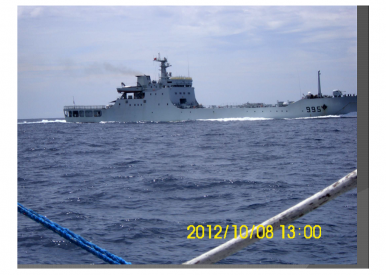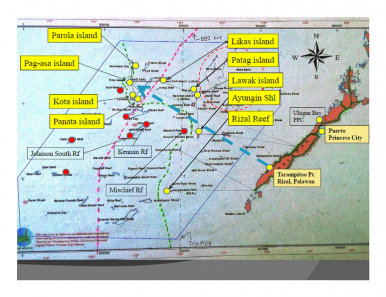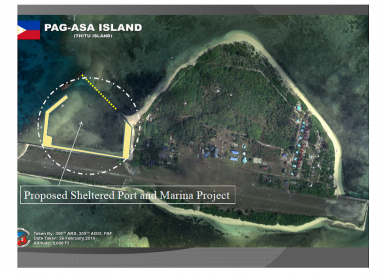The Diplomat talks with Mayor Eugenio Bito-onon about governing an area in the middle of the South China Sea disputes.

A view of a Chinese vessel taken from a convoy the mayor was in on the way to Pag-asa in October 2012. Image Credit: Mayor Eugenio Bito-onon
Eugenio “Jun” Bito-onon is the mayor of Kalayaan municipality, which comprises six islets controlled by the Philippines in the disputed Spratly Islands in the South China Sea, the islands are claimed by several other countries including China. These islets include Pag-asa Island, which houses nearly 200 inhabitants. During his recent visit to Washington, D.C., Bito-onon spoke with The Diplomat’s associate editor Prashanth Parameswaran about his perspective on the South China Sea. An edited version of that interview follows.
Much has been written about China’s growing assertiveness in the South China Sea and its impact on claimants like the Philippines over the past few years. You have personally had encounters with Chinese warships in the South China Sea. Can you tell us a bit about your experience, and how that has informed your view on the issue and China’s role in it?
I have had several experiences with Chinese vessels at sea. One incident happened on October 8, 2012. This was during the maiden voyage of the MV Queen Seagull, a wooden hull cargo and passenger boat owned and operated by Kalayaan municipality. The MV Queen Seagull had set sail from Puerto Princesa City port for a routine delivery of supplies to Pag-asa Island, and it was joined by three other boats in Bancalaan Island, an island located at the southernmost tip of Palawan.

A local government map of the Kalayaan Islands including Pag-asa Island. (Photo Credit: Provincial Planning and Development Office).
After the convoy had passed by Second Thomas Shoal and stopped to take shelter at Sabina Shoal due to inclement weather, we departed from Lawak Island early on October 8 a few hours before dawn. When we had passed Likas Island (West York Island) for about an hour while heading west to Pag-asa, the boat captain in the MV Queen Seagull spotted a fast approaching vessel heading directly for it.
When the radio operator informed me and mentioned that the approaching vessel had not responded to calls, I immediately said that it must be a Chinese vessel with a crew not comprehending English. When I came out of the cabin, I discovered that it was a warship, silver gray in color with bow number 995 heading northward. I shouted for anybody with a camera to take pictures and video footage and someone successfully did it, with the pictures indicating a date and time of October 8 at 13:00 hours (the picture is shown above). I used this evidence in my report to the Western Command and the National Security Administration, and I also told the story to local radio and friends in the national media.
Though I had initially thought that the warship was just passing by on its way to China, at 16:00 hours, with just an hour left to Pag-asa, it crossed our convoy again between the third and last boat. I noticed that it slowed down and was lying tow within viewing distance left of our convoy. Meanwhile, to the right side of our convoy, a wide reef 5-9 kilometers from Pag-asa Island was billowing with smoke coming from the exhaust of numerous Chinese diesel-engine sampans used to dig giant clams, which I also took pictures of from a distance. It dawned on me that if these boats were to be apprehended, a repeat of the Scarborough Shoal incident would occur. It would be a tough job to drive and prevent them from destroying the coral reef.
In August 2014, I took Asahi Shimbun and Asahi TV to Second Thomas Shoal. While approaching the southern part of the feature at 8pm, we were suddenly blocked and harassed by a Chinese coast guard vessel. We were streamed with strong search light and blared with horn. But our boat captain prevailed by going around the rear part of the big boat until we got into the shallow area and the lagoon.
As someone who is on the front lines in the South China Sea, what is your assessment of the approach that the current government, led by President Benigno Aquino III, has taken on the issue?
Pag-asa Island, which you govern, has nearly 200 inhabitants. Can you give us a sense of how is it sustained as an entity that supports civilian life? And how is it governed and secured?
Well, the municipality continuously receives support from the national government in terms of Internal Revenue Allotment (IRA). For 2016 for instance, the forecast of IRA for Kalayaan municipality is 59 million pesos. The funds, which other municipalities and cities in the Philippines also receive, are governed by certain policies and laws which determine how they ought to be spent. For example, for a fifth class municipality like Kalayaan, a maximum of 55 percent of it is allowed for personal services, 20 percent for development, 5 percent for calamity, and so on.
That being said, there are some steps that we take to account for the unique nature of Pag-asa Island. Due to a lack of arable land, the municipal government ensures food security by providing a month food subsidy consisting mainly of 14 kilograms of rice per adult resident. To facilitate the processing of financial transactions, the local government of Kalayaan has set up an Extension Office in Puerto Princesa City.
In terms of governance, there are two administrators who assist me in handling daily affairs – one based in Pag-asa and another in Puerto Princesa City. The municipality also owns and operates a marine transport vessel to ensure it can conduct basic tasks – like transporting construction materials for projects – on its own without relying on the military. Nonetheless, in most cases the military is very supportive and graciously extends accommodation or transportation services or assistance to the municipal government and its constituents in between quarterly municipal trips.

An aerial view of Pag-asa Island taken back in 2014. (Photo Credit: Armed Forces of the Philippines).
You have proposed an eco-tourism zone (ETZ) in the Kalayaan Islands. Can you briefly outline the rationale for this, and what it would entail?
How has your proposal been received by the Philippine government thus far?
The proposal for an ETZ is still a work in progress. But how have the Chinese government as well as various Chinese entities and interests responded to economic initiatives like these over the past few years?
You are now in the midst of a public awareness campaign to the United States until early October. What more do you think the United States can do in assisting the Philippines in the South China Sea?
I learned that there have been many conflicts in the world that were eventually resolved peacefully. There are scholars and scientists who have been advancing ideas on how to promote peace in the South China Sea. For example, I learned of John McMannus’ proposal to pattern the resolution of the problem in South China Sea after the Antarctica model. I think that without a capable and interested arbiter(s) or negotiator(s) that could intervene in the situation, China will continue to bully and harass weaker states in the South China Sea considering that it has already dwarfed all other occupants with its man-made islands. The United States can come to the aid of weaker and smaller countries as an intervenor or broker.
http://thediplomat.com/2015/09/interview-a-philippine-perspective-from-the-middle-of-the-south-china-sea/
Much has been written about China’s growing assertiveness in the South China Sea and its impact on claimants like the Philippines over the past few years. You have personally had encounters with Chinese warships in the South China Sea. Can you tell us a bit about your experience, and how that has informed your view on the issue and China’s role in it?
I have had several experiences with Chinese vessels at sea. One incident happened on October 8, 2012. This was during the maiden voyage of the MV Queen Seagull, a wooden hull cargo and passenger boat owned and operated by Kalayaan municipality. The MV Queen Seagull had set sail from Puerto Princesa City port for a routine delivery of supplies to Pag-asa Island, and it was joined by three other boats in Bancalaan Island, an island located at the southernmost tip of Palawan.

A local government map of the Kalayaan Islands including Pag-asa Island. (Photo Credit: Provincial Planning and Development Office).
After the convoy had passed by Second Thomas Shoal and stopped to take shelter at Sabina Shoal due to inclement weather, we departed from Lawak Island early on October 8 a few hours before dawn. When we had passed Likas Island (West York Island) for about an hour while heading west to Pag-asa, the boat captain in the MV Queen Seagull spotted a fast approaching vessel heading directly for it.
When the radio operator informed me and mentioned that the approaching vessel had not responded to calls, I immediately said that it must be a Chinese vessel with a crew not comprehending English. When I came out of the cabin, I discovered that it was a warship, silver gray in color with bow number 995 heading northward. I shouted for anybody with a camera to take pictures and video footage and someone successfully did it, with the pictures indicating a date and time of October 8 at 13:00 hours (the picture is shown above). I used this evidence in my report to the Western Command and the National Security Administration, and I also told the story to local radio and friends in the national media.
Though I had initially thought that the warship was just passing by on its way to China, at 16:00 hours, with just an hour left to Pag-asa, it crossed our convoy again between the third and last boat. I noticed that it slowed down and was lying tow within viewing distance left of our convoy. Meanwhile, to the right side of our convoy, a wide reef 5-9 kilometers from Pag-asa Island was billowing with smoke coming from the exhaust of numerous Chinese diesel-engine sampans used to dig giant clams, which I also took pictures of from a distance. It dawned on me that if these boats were to be apprehended, a repeat of the Scarborough Shoal incident would occur. It would be a tough job to drive and prevent them from destroying the coral reef.
In August 2014, I took Asahi Shimbun and Asahi TV to Second Thomas Shoal. While approaching the southern part of the feature at 8pm, we were suddenly blocked and harassed by a Chinese coast guard vessel. We were streamed with strong search light and blared with horn. But our boat captain prevailed by going around the rear part of the big boat until we got into the shallow area and the lagoon.
There were several other experiences as well. But all of them led me to believe that what I have read and heard about China’s aggression is related to its dream of taking the whole of the South China Sea in disregard of the United Nations Convention on the Law of the Sea (UNCLOS) to which she is a signatory. I am made to believe that the oil and gas in the Reed Bank is its main target of China after learning that the Department of Energy has extended the exploration contract of Forum Energy for another three years because of China’s harassment.
I think the best move that President Aquino did was the filing of the arbitration case. I fully appreciate and support the filing of the arbitration case to once and for all resolve the issues and problems. I believe it will provide permanent solutions to the messy situation that we are in today. As mayor of a local government unit with a handful of constituents but gaining consistent support from the national government in terms of Internal Revenue Allotment (IRA) funds, we can still be patient enough to wait for the results of case.
Well, the municipality continuously receives support from the national government in terms of Internal Revenue Allotment (IRA). For 2016 for instance, the forecast of IRA for Kalayaan municipality is 59 million pesos. The funds, which other municipalities and cities in the Philippines also receive, are governed by certain policies and laws which determine how they ought to be spent. For example, for a fifth class municipality like Kalayaan, a maximum of 55 percent of it is allowed for personal services, 20 percent for development, 5 percent for calamity, and so on.
That being said, there are some steps that we take to account for the unique nature of Pag-asa Island. Due to a lack of arable land, the municipal government ensures food security by providing a month food subsidy consisting mainly of 14 kilograms of rice per adult resident. To facilitate the processing of financial transactions, the local government of Kalayaan has set up an Extension Office in Puerto Princesa City.
In terms of governance, there are two administrators who assist me in handling daily affairs – one based in Pag-asa and another in Puerto Princesa City. The municipality also owns and operates a marine transport vessel to ensure it can conduct basic tasks – like transporting construction materials for projects – on its own without relying on the military. Nonetheless, in most cases the military is very supportive and graciously extends accommodation or transportation services or assistance to the municipal government and its constituents in between quarterly municipal trips.
The Armed Forces of the Philippines (AFP) deploys units to all the islets and several branches of AFP are present in Pag-asa Island for defense and security purposes. Peace and order is taken care of by our police from the Philippine National Police and the Barangay tanods (community peace keepers).

An aerial view of Pag-asa Island taken back in 2014. (Photo Credit: Armed Forces of the Philippines).
You have proposed an eco-tourism zone (ETZ) in the Kalayaan Islands. Can you briefly outline the rationale for this, and what it would entail?
The Ecotourism Zone Proposal is a municipal government initiative intended to serve as a peaceful solution to the increasing militarization in the Kalayaan islands. It is designed to show the direction and the aspiration of the municipal government. It actually started from the concept of “Tourism for Peace” which envisions future cooperation and bringing people together, learning about their culture, enhancing connectedness, and providing relevant job and livelihood opportunities. With ecotourism comes adequate environmental and ecological protection of certain areas zoned for tourism investment.
Because of the Bottom Up Budgeting (BUB) Program, funds have been allocated by several national government agencies for our access, and it is in this context that we have proposed our tourism-related projects. This year, we have signed several agreements regarding counterparting of funds with the Department of Interior and Local Government (DILG) for the acquisition of a steel boat, and with the Department of Tourism for the construction of a souvenir or coffee shop to serve as a passenger lounge in Pag-asa and the preparation of Kalayaan Tourism Master Plan in 2016. I think the timing is good and things have started this year while awaiting the final results of the arbitration case.
I think the Chinese government has been eager to negotiate with the Philippines about cooperation in ecotourism and fisheries. It is the Philippine government that is hesitant and it has been insisting that this should not occur until the arbitration case is over. So, no matter what kind of economic engagement is offered by any Chinese entities in the area of the West Philippine Sea, the Philippines is overcome with great doubt over their intentions. The local government cannot act on its own on this issue. Instead, it takes advice from relevant national agencies especially the Department of Foreign Affairs and Office of the President.
I learned that there have been many conflicts in the world that were eventually resolved peacefully. There are scholars and scientists who have been advancing ideas on how to promote peace in the South China Sea. For example, I learned of John McMannus’ proposal to pattern the resolution of the problem in South China Sea after the Antarctica model. I think that without a capable and interested arbiter(s) or negotiator(s) that could intervene in the situation, China will continue to bully and harass weaker states in the South China Sea considering that it has already dwarfed all other occupants with its man-made islands. The United States can come to the aid of weaker and smaller countries as an intervenor or broker.
http://thediplomat.com/2015/09/interview-a-philippine-perspective-from-the-middle-of-the-south-china-sea/

No comments:
Post a Comment
Note: Only a member of this blog may post a comment.